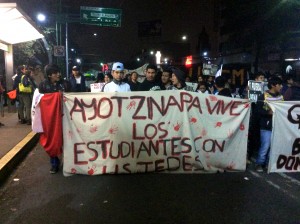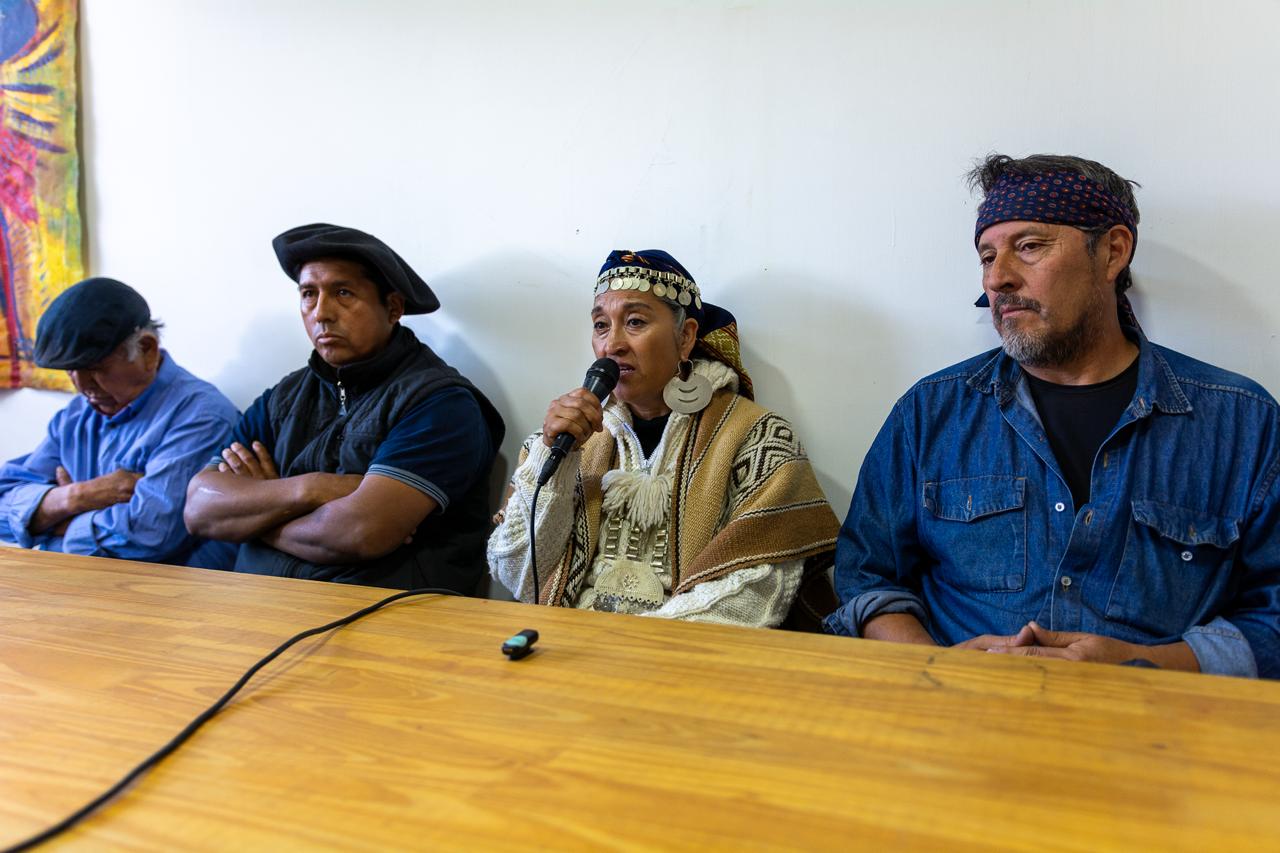 Thousands of students marched from Tlatelolco Square, site of the notorious student massacre of 1968, to the Zocalo in Mexico City Nov. 20 in solidarity with the 43 disappeared students of the Raúl Isidro Burgos Rural Teachers’ College in Ayotzinapa, Guerrero. The student march, which included vast participation of both public and private universities and high schools, followed national strikes organized in 79 universities throughout the country.
Thousands of students marched from Tlatelolco Square, site of the notorious student massacre of 1968, to the Zocalo in Mexico City Nov. 20 in solidarity with the 43 disappeared students of the Raúl Isidro Burgos Rural Teachers’ College in Ayotzinapa, Guerrero. The student march, which included vast participation of both public and private universities and high schools, followed national strikes organized in 79 universities throughout the country.
Prior to the march in Mexico City university students suspended classes and occupied their universities in support of the Global Day of Action for Ayoztinapa. Some of the universities that participated in the national strike organized by the Interuniversity Assembly included the campuses of the National Autonomous University of Mexico, campuses of the National Polytechnic Institute (IPN), The Autonomous University of Chihuahua, the Autonomous University of the State of Mexico and the University of Guanajuato.
For many students present at Thursday’s march, it was there first time participating in the massive protests that have paralyzed Mexican cities in the recent weeks. Although less politically active then the students from the Philosophy and Political Science students, the medical students of the National Autonomous University of Mexico expressed their commitment to the protests against the disappearance of the students in Guerrero.
Abraham Hernandez, second year medical student, explained the growing support within his school, “We have gone from an organizing committee of five students to five hundred. Our assembly included technicians, students and professors and we have been able to organize two strikes successfully. Just today we voted to go on strike in our school with 12,000 students in support and 500 against.” This sort of involvement is astounding considering the relative absence of prior social protest participation of the medical students. Abraham explains that his participation in the assembly and organizing and seeing so many of his classmates marching have made him optimistic.
Students of teachers’ colleges from around the country joined the march in support of their colleagues, including students from all five Mexico City schools. Claudia Rosas Rosas, student of the Benemérita National Teacher School specializing in Elementary Education, expressed her solidarity with the Ayoztinapa students. As a normalista she ponders what it is to fear being unable to return to the classroom to learn, to continue her education.
Claudia explains, “There has always existed a sense of camaraderie among normalistas on a national scale. But considering what has happened in Ayoztinapa, this camaraderie is now fueled by collective indignation.” Students are optimistic as participation in protests is increasing in Mexico, including students entire families, workers, teachers, and musicians.
Claudia explains that students occupy an important role in this struggle, “At this moment, we are the majority and we as youth have power. We have the power to make demands–of our parents, of the government–that they listen to us. Confronted with barbarism, we choose empathy. Of influencing fear in our government, of reversing the role. We are creating a strong and organized base.”
For many students Thursday’s protest was also an opportunity to link the disappearance of students in Guerrero with student struggles they face on a national scale, fortifying solidarity and networks of student political mobilization in the country. Also present at the march were students from the National Polytechnic Institute (IPN) that since September mounted large and organized protests against the reform of curriculum and internal regulations. Several campuses all over Mexico City were taken over by the students in late September after IPN authorities proposed regulations that would eliminate several important subjects in the curriculum, would grant students the accreditation not of engineer but technicians, and would implement new fees for extra curricular activities. Since September, students, professors and families have taken to the streets to protest and have organized strikes. Daniel Antonio, senior at the School for Civil Engineering, expressed that his participation in last night’s march was the perfect opportunity to unify student struggles on a national scale. “Today’s march represents the unification of the different student struggles. Unifying the Polytechnic’s strikes and the disappearances of the Ayoztinapa students.” Daniel’s classmate, Edgar Jimenez reiterates the need to consolidate student struggles and expresses that their indignation is symptomatic of a larger and more widespread social unrest, “Our university strikes represent the accumulation of social unrest in our country. It has reached a national level and it is manifesting and inspiring us to take the streets, it is inspiring people to participate and make their discontent public.”
Israel Rodrigo Flores, communications student of the Autonomous University of Mexico City (UACM), not only expressed his solidarity with the Polytechnic’s student protests and Ayoztinapa, but with the need to continue to promote social change as students. “We find ourselves in an important time in Mexico. Unfortunately our governments are repressing the student population, they attempt to modify the syllabi of universities, and we are mobilizing because we cannot stand by as our rights are infringed upon.” Israel explains, “We are not just students from the teaching college, we are not only UACM, we are not only UNAM, we are all a community that believes that education can change the current crisis. We believe that there are 43 missing in Ayotzinapa, which are 43 of our brothers, this fight is for them and they are us because yesterday it was them, the day before yesterday it was the student massacre of 1968, maybe today or tomorrow it could be one of us. We have the right to go to school and return home alive.”
Repression of students has escalated in the last two years under the Enrique Peña presidency. During his inauguration on December 1, 2012, 96 otherwise peaceful protestors and civilians were detained under charges of disruption of public peace while they participated in the march organized by the #YoSoy132 student collective in protest of the corrupt electoral process that implemented the buying of votes and manipulation of ballots. Since then, the massive mobilizations in Mexico City, which includes the historic and symbolic protests that commemorates the massacre of student activists and civilians in Tlatelolco on Oct. 2, have been marred by the arbitrary arrest of youth and students. While social unrest has escalated in the last three months due to the outcry of the disappearance of the 43 normal rural school students in Guerrero, police confrontation with students has also escalated.
During the march, the School of Advanced Studies Aragón affiliated with the National Autonomous University of Mexico, announced the arbitrary arrest of their classmate and economy student Jacqueline Selene Santa Lopez, detained on September 15 and charged with assault and robbery of a female police officer. Jacqueline was detained, along with her boyfriend Bryan Reyes Rodriguez, also a student, in the Venustiano Carranza Delegation of Mexico City by fourteen federal police agents dressed as civilians who neither showed identification nor expressed the charges against the couple. Jacqueline is being held at the Santa Martha Acatitla women’s prison where her classmates report she has been subjected to verbal and physical abuse. Jacqueline is an active organizer in her school and has participated extensively in the local protests in support of the Ayotzinapa students.
Five days before the national strike and march in support of the Ayoztinapa students, an agent of the Attorney General of the Federal District (PGJDF) fired rubber bullets onto a crowd of students convened outside the Che Guevara Auditorium located on the main campus of the National Autonomous University of Mexico, injuring a male student and gravely violating the autonomy of Mexico’s largest and most emblematic public university. The students had convened for an internal organizational meeting for the upcoming protests. During the protest on Thursday night high school student Diego Lovera, from the College of Education and Technology’s High School in the state of Mexico, expressed the urgency in participating in the day’s march considering that Mexican government is increasingly infringing on the rights and autonomy of students. Lovera fears that if he doesn’t protest now he is in danger of losing his autonomy, “if they violated UNAM’s autonomy, what will they do to those of us who have none?”
Nidia Bautista is a journalist and member of the team of the Americas Program.



